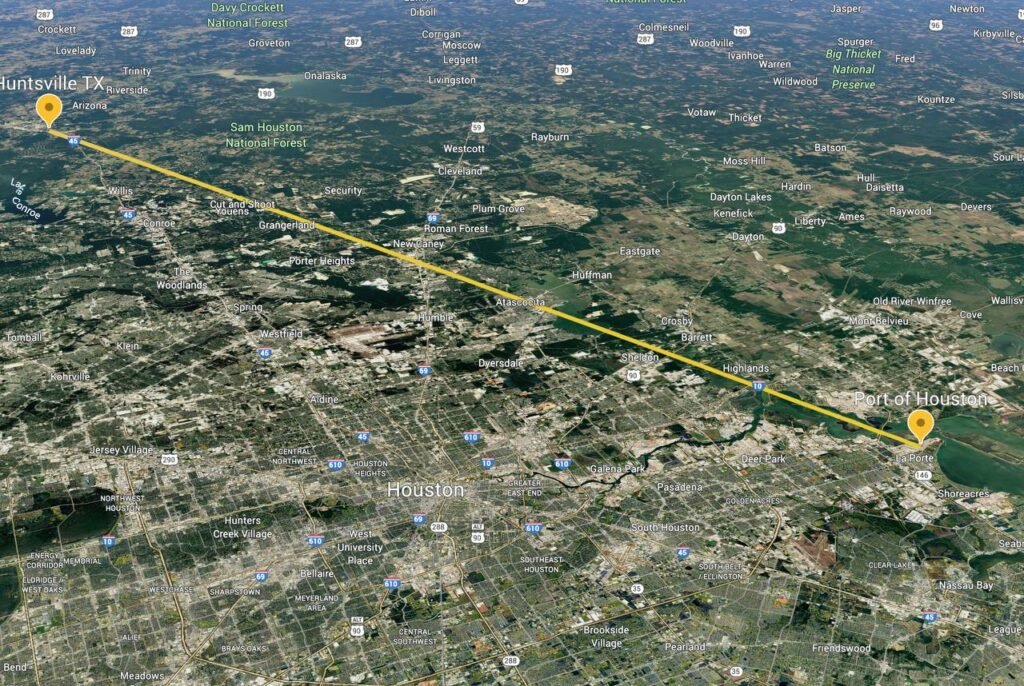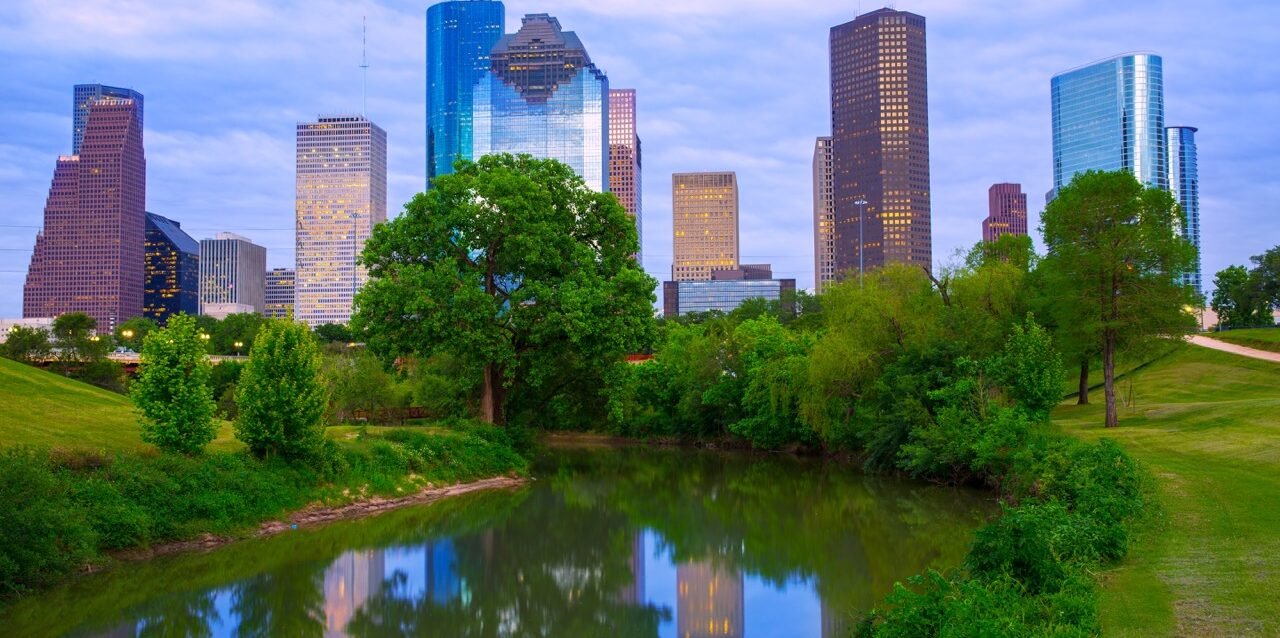Executive Summary
Houston, the vibrant epicenter of Texas innovation, energy, and opportunity, faces a defining challenge as its metro population is projected to surge to 10.7 million by 2050—a remarkable increase of about 3.2 million residents from today’s 7.5 million. Without transformative action, this growth will exacerbate inefficiencies in the trucking industry, strain obsolete infrastructure, and overburden archaic systems, leading to crippling congestion, infrastructure costs soaring beyond $109 billion regionally, household expenses climbing by thousands annually, environmental costs in the billions from heightened emissions, and a potential drag on Texas’ Gross State Product (GSP) amounting to tens of billions in lost productivity. But there’s immense reason for optimism: The American Dream Rail system, a cutting-edge, scalable solution for passenger and freight transport connecting the Port of Houston to a new distribution center in Huntsville, TX (77 miles away), can turn this tide. By capturing 50% of the port’s freight volume, reducing transport costs and delivery times by 50%, and slashing emissions by 75%, this system—fully operational by 2035—will enhance efficiency, generate substantial city revenue through an Air-Use tax, and deliver widespread benefits without disrupting security or daily life.
In the “after” scenario, Houston emerges stronger, with boosted GSP, lighter household burdens, and averted shortfalls. The urgency is undeniable: Embrace this innovation now, and propel Houston into a thriving, sustainable future.

Introduction
Picture a Houston where freight flows effortlessly overhead, bypassing jammed highways, where commuters reclaim precious time, and where cleaner air fosters healthier communities for decades ahead. This vision is achievable through groundbreaking solutions like the American Dream Rail. As the nation’s fourth-largest city accelerates toward unprecedented growth, the implications for transportation are profound and immediate. This case study explores the economic and social ramifications of Houston’s projected population growth to 10.7 million by 2050 on the mobility of citizens and goods. We contrast the “before” outlook—a mounting crisis of trucking inefficiencies, outdated infrastructure, and antiquated systems—with the “after,” where the American Dream Rail revolutionizes operations. Leveraging updated projections, economic analyses, and system details, we address emerging needs, costs, shortfalls, consequences, GSP impacts, and emission expenses. The narrative builds urgency: Delay invites disaster, but swift adoption unlocks prosperity. Optimistically, this rail, funded by a $5.5trillion national legacy initiative, offers scalability and security, positioning Houston as a global leader in efficient, eco-friendly transport.
Background Information
Houston’s legacy as a powerhouse of energy, commerce, and cultural diversity fuels Texas’ economic engine. The metro area, currently home to approximately 7.5 million people, is forecasted to reach 10.7 million by 2050, fueled by expansions in energy, healthcare, and manufacturing sectors. This 42% rise will amplify pressure on transportation networks handling over 179 million daily vehicle miles traveled (VMT), projected to climb significantly with growth. The Port of Houston, a vital global gateway, handled a record 53 million tons of cargo in 2024, with container volumes contributing significantly. However, dependence on inefficient trucking—riddled with delays, accidents, and emissions—intensifies problems. Much of the infrastructure dates back decades, while traffic systems lag in modernity. Economically, Texas’ GSP exceeds $2 trillion, with freight playing a pivotal role; inefficiencies already erode billions in output. Socially, congestion costs drivers an average of around 50+ hours annually, equating to $900+ per driver. Emissions from transport, accounting for nearly half of the city’s pollution, fuel health issues. Time is of the essence: Unchecked growth could paralyze the city, but rail innovations promise renewal.
Problem or Challenge (Before Scenario)
The population explosion in Houston isn’t mere statistics—it’s a looming crisis poised to overwhelm transportation, jeopardizing economic growth and resident well-being. An additional 3.2 million people by 2050 will heighten demands on inefficient trucking, aging infrastructure, and outdated systems, creating havoc in citizen and goods movement.
○ New Essential Needs for the City and People:
Expanded highways and bridges to accommodate increased vehicles.
Bolstered public transit options, such as additional buses and rail lines, to temper VMT escalation.
Modernized port and distribution facilities for freight volumes projected to more than double statewide by 2050.
Cutting-edge traffic tech to alleviate delays and crashes.
Sustainable alternatives to curb transportation’s 47% emissions share.
○ Breakdown of Projected Costs to the City:
Regional investments: $109 billion through 2050 for 750+ projects encompassing highways and transit.
Broader statewide needs driven by growth: Up to $140 billion in combined local, state, and federal funding.
Ongoing maintenance: Additional billions for deteriorating infrastructure, with annual congestion costs exceeding $10 billion statewide.
○ Cost to Individual Households:
Yearly congestion hit: Around $900–$1,000 per driver in time and fuel losses.
Tax implications: Households may shoulder $2,000–$3,000 extra annually through property and sales taxes to support the $109 billion plan (spread across ~3.5 million households by 2050).
Indirect health/environmental tolls: Emissions-related illnesses could add hundreds in costs, with potential savings of millions if addressed.
○ Projected Shortfalls:
Funding deficits: Despite $109 billion, growth could create 20–30% gaps if federal support wanes.
Capacity constraints: Trucking bottlenecks may affect 50% of freight, overwhelming roads with VMT spikes.
Regulatory hurdles: Emissions could rise significantly without upgrades, violating standards.
○ Potential Consequences for Failing to Meet Shortfalls:
Economic slowdown: Freight delays might trim 1–2% from GSP growth, costing $20–40 billion yearly.
Social fallout: Heightened accidents (trucks in 10%+ fatalities), health epidemics from pollution, and diminished quality of life.
Climate risks: Surging emissions, comprising half of Houston’s footprint, heighten vulnerability.
○ Effect on Gross State Product (GSP):
Efficiency losses: Congestion and bottlenecks could cumulatively deduct $50–100 billion from Texas’ GSP by 2050, given freight’s significant contribution.
○ Cost of Increased Emissions:
Annual burden: $1–2 billion in health and economic damages (at ~$50/ton social cost; Houston’s transport emits substantial GHG).
Cumulative to 2050: $30–50 billion regionally, exacerbated by truck pollutants.
The imperative is clear: Inaction could gridlock Houston’s progress, demanding urgent, bold steps.
Myron Manuirirangi
Solution or Approach (American Dream Rail System)
Behold the American Dream Rail—a revolutionary, scalable network for passengers and freight that soars above obstacles while upholding security and urban rhythm. Linking the Port of Houston to Huntsville’s new distribution center (77 miles north), it shifts freight processing inland to optimize port resources, enhance load matching, and expedite turnover, passing savings to U.S. industry. Key advantages:
Overflying congestion, delays, detours, and closures.
Decreasing truck volumes on roadways.
Eradicating accident potentials.
Halving goods transport costs.
Cutting delivery times by 50%.
Reducing emissions by 75%.
Backed by $5.5 trillion in legacy funding, it targets 50% of the port’s 38.2 million short tons container freight (19.1 million short tons), handling 52,374 short tons daily at 45 mph with 436 vehicles spaced 0.355 miles apart every 28.4 seconds. Revenue at $6 per 100-ton mile yields city benefits via a 16% Air-Use tax.
Implementation
Deployment is efficient and forward-looking: Full operation by 2035, with track construction at $35 million per mile ($2.695 billion total) and vehicles at $150,000 each ($65.4 million). Phased from port outward, the elevated system integrates seamlessly with advanced security, minimizing disruptions. Revenue math: 19.1M tons × 77 miles = 1,471M ton-miles; at $0.06/ton-mile, gross $88.3M; city tax $14.1M yearly. This funds sustainability, amplifying gains.
After Scenario and Comparison
Post-rail, growth fuels prosperity: Economic surges add $10–20 billion to GSP via streamlined freight; socially, safer streets, time savings (50+ hours/year per person), and 75% emission cuts prevent deaths and save $1–2 billion in health costs. Shortfalls evaporate as rail absorbs half the freight, easing infrastructure loads.
Compare-and-Contrast Cost/Savings Differentials:
- Infrastructure Costs: Before: $109B strain; After: 20–30% reduction ($20–30B saved) from lower truck/road demands.
- Household Costs: Before: $2,000–$3,000/year; After: Slashed to $1,000–$1,500, plus $500+ in time value.
- Emission Costs: Before: $1–2B/year; After: 75% drop saves $750M–$1.5B, enhanced by green transport.
- GSP Effect: Before: $50–100B loss; After: Equivalent gain from efficiencies.
- Overall Savings: Rail’s 50% reductions deliver $44M+ yearly to industry; city nets $14.1M tax.
Before: Perilous overload; after: Empowered ascent. The call to action is now—Houston’s bright future awaits!
#SignForAmericaLet’s make America unstoppable.
Sign the petition today for your sake, more so than President Trump’s.
Phone Numbers
Work: +1 (305) 000-0000
Support: +1 (888) 000-0000
Our Location
Work: +1 (305) 000-0000
Support: +1 (888) 000-0000
American Patriots, Inc., c/- dba: American Dream Rail Legacy Project
Miami FL, 33127
contact@AmericanDreamRail.com



